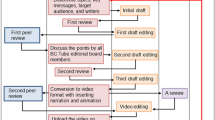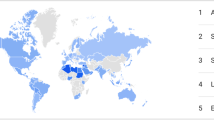Abstract
The quality and accuracy of health content posted on YouTube varies widely. To increase dissemination of evidence-based gynecologic cancer information to US YouTube users, the Centers for Disease Control and Prevention (CDC) sponsored two types of advertisements: (1) pre-roll videos that users had to watch for at least 5 s before seeing a video they selected and (2) keyword-targeted listings that appeared in search results when users entered terms related to gynecologic cancer. From July 2012 to November 2013, pre-roll videos were shown 9.2 million times, viewed (watched longer than the mandatory 5 s) 1.6 million times (17.6 %), and cost $0.09 per view. Keyword-targeted listings were displayed 15.3 million times, viewed (activated by users) 59,766 times (0.4 %), and cost $0.31 per view. CDC videos in advertisements played completely in 17.0 % of pre-roll video views and 44.4 % of keyword-targeted listing views. Advertisements on YouTube can disseminate evidence-based cancer information broadly with minimal cost.
Similar content being viewed by others
References
Alexa (2015) The top 500 sites on the web. Available at www.alexa.com/topsites (accessed 13 March 2015)
Madathil KC, Rivera-Rodriguez AJ, Greenstein JS, Gramopadhye AK (2014) Healthcare information on YouTube: a systematic review. Health Informatics J. doi:10.1177/1460458213512220
Steinberg PL, Wason S, Stern JM, Deters L, Kowal B, Seigne J (2010) YouTube as source of prostate cancer information. Urology 75:619–622
Ache KA, Wallace LS (2008) Human papillomavirus vaccination coverage on YouTube. Am J Prev Med 35:389–392
Backinger CL, Pilsner AM, Augustson EM, Frydl A, Phillips T, Rowden J (2011) YouTube as a source of quitting smoking information. Tob Control 20:119–122
Bromberg JE, Augustson EM, Backinger CL (2012) Portrayal of smokeless tobacco in YouTube videos. Nicotine Tob Res 14:455–462
Luo C, Zheng X, Zeng DD, Leischow S (2014) Portrayal of electronic cigarettes on YouTube. BMC Public Health 14:1028
Nason GJ, Kelly P, Kelly ME, Burke MJ, Aslam A, Giri SK, Flood HD (2015) YouTube as an educational tool regarding male urethral catheterization. Scand J Urol 49:189–192
Kumar N, Pandey A, Venkatraman A, Garg N (2014) Are video sharing Web sites a useful source of information on hypertension? J Am Soc Hypertens 8:481–490
Lee JS, Seok SH, Hong TH (2014) YouTube as a source of patient information on gallstone disease. World J Gastroenterol 20:4066–4070
Keelan J, Pavri-Garcia V, Tomlinson G, Wilson K (2007) YouTube as a source of information on immunization: a content analysis. J Am Med Assoc 298:2482–2484
Mukewar S, Mani P, Wu X, Lopez R, Shen B (2013) YouTube and inflammatory bowel disease. J Crohn's Colitis 7:392–402
Pant S, Deshmukh A, Murugiah K, Kumar G, Sachdeva R, Mehta JL (2012) Assessing the credibility of the ‘YouTube Approach’ to health information on acute myocardial infarction. Clin Cardiol 35:281–285
Centers for Disease Control and Prevention (2015) Inside knowledge: get the facts about gynecologic cancer. Available at www.cdc.gov/cancer/knowledge (accessed 13 March 2015)
Cooper CP, Gelb CA, Chu J (2014) What’s the appeal? Testing public service advertisements to raise awareness about gynecologic cancer. J Women's Health 23:488–492
Acknowledgments
This study was funded by the Centers for Disease Control and Prevention. However, the findings and conclusions in this paper are those of the authors and do not necessarily represent the official position of the Centers for Disease Control and Prevention.
Author information
Authors and Affiliations
Corresponding author
Rights and permissions
About this article
Cite this article
Cooper, C.P., Gelb, C.A. & Chu, J. Gynecologic Cancer Information on YouTube: Will Women Watch Advertisements to Learn More?. J Canc Educ 31, 602–604 (2016). https://doi.org/10.1007/s13187-015-0830-3
Published:
Issue Date:
DOI: https://doi.org/10.1007/s13187-015-0830-3




